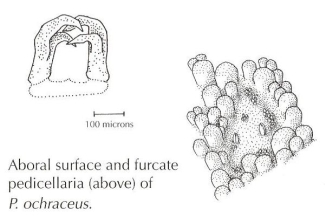The Ochre or Purple Star,
Pisaster ochraceus, is by far the most common sea star in British Columbia and along much of northwest coast of North America. The species primarily eats mussels and barnacles, but has a broad range of other dietary items. Its role in the community dynamics of the shore is so influential that it has been termed a "keystone predator", that is, a species of high trophic status that through its feeding activities exerts a disproportionate influence on community structure. Much research has been done on the species' feeding ecology and also on its coloration. In fact, the functional morphology of its predominant purple, brown, and orange colours has engaged the interest and curiosity of researchers for decades. If you would like to read about current research on this subject, and to learn why marine biologists on the coast are desperate for someone with lots of time on their hands to come along and rear up several thousands of these sea stars under different conditions of diet, salinity, parenthood, and so on, then visit
A SNAIL'S ODYSSEY.
Introduction Note Author: Tom Carefoot, Department of Zoology, University of British Columbia
Family Description
Five or more arms. At least one adambulacral is fused into an adoral carina. The adambulacrals are wider than their length. Crossed and straight pedicellariae are present, the former usually in dense tufts around the spines. The aboral skeleton is meshlike. The tube feet are arranged in four rows.
